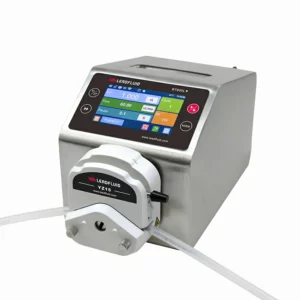Peristaltic pumps are commonly used to dose a wide range of chemicals in various industries due to their precise flow rate control, compatibility with different fluids, and contamination-free pumping action.
Here are some examples of chemicals that are often dosed using peristaltic pump flow rate:
- Acids and Bases: Peristaltic pumps are frequently used to dose acids (e.g., hydrochloric acid, sulfuric acid, nitric acid) and bases (e.g., sodium hydroxide, potassium hydroxide) in chemical processing, water treatment, and laboratory applications. These chemicals may be dosed for pH adjustment, neutralization, or chemical reactions.
- Solvents: Peristaltic pumps are suitable for dosing solvents such as acetone, ethanol, methanol, isopropanol, and various organic solvents. Solvent dosing applications include sample preparation, chromatography, solvent extraction, and solvent-based cleaning processes.
- Reagents and Buffers: In laboratories and analytical chemistry, peristaltic pumps are used to dose reagents, buffers, and electrolyte solutions for experiments, assays, and analytical instrumentation. Common examples include phosphate buffers, Tris buffers, saline solutions, and enzyme substrates.
- Detergents and Surfactants: Peristaltic pumps are employed in industrial cleaning and sanitation processes to dose detergents, surfactants, disinfectants, and sanitizing solutions. These chemicals may be dosed for cleaning equipment, surfaces, or products in manufacturing facilities, food processing plants, and healthcare settings.
- Polymer Solutions: Peristaltic pumps are used to dose polymer solutions, including polymers such as polyethylene glycol (PEG), polyvinyl alcohol (PVA), polyacrylic acid (PAA), and polyethyleneimine (PEI). Polymer solutions may be dosed for coating, adhesion, encapsulation, or surface modification applications.
- Biological Reagents: Peristaltic pumps are employed in biotechnology, life sciences, and pharmaceutical manufacturing to dose biological reagents such as enzymes, proteins, antibodies, cell culture media, and growth factors. peristaltic pump flow rate These reagents are dosed for cell culture, fermentation, purification, and bioprocessing applications.
- Flocculants and Coagulants: In water and wastewater treatment plants, peristaltic pumps are used to dose flocculants and coagulants such as aluminum sulfate (alum), ferric chloride, and polyacrylamide. These chemicals are dosed to facilitate particle aggregation and sedimentation in clarifiers and settling tanks.
- Additives and Preservatives: Peristaltic pumps are employed in food and beverage manufacturing to dose additives, preservatives, flavorings, colorants, and nutritional supplements. These additives may be dosed into food products, beverages, or processing streams to enhance taste, appearance, shelf life, or nutritional content.
- Specialty Chemicals: Peristaltic pumps are used to dose a wide range of specialty chemicals and reagents in niche industries and applications. Examples include corrosion inhibitors, antiscalants, antifoulants, lubricants, adhesives, sealants, and specialty coatings.
- Herbicides and Pesticides: In agriculture and horticulture, peristaltic pumps are employed to dose herbicides, pesticides, fungicides, and fertilizers. These chemicals are dosed for crop protection, pest control, weed management, and soil nutrient supplementation.
These are just a few examples of the diverse range of chemicals that can be dosed using peristaltic pump flow rate. Peristaltic pumps offer precise and reliable dosing capabilities for a wide range of industrial, laboratory, and process applications involving liquid chemicals and reagents.
